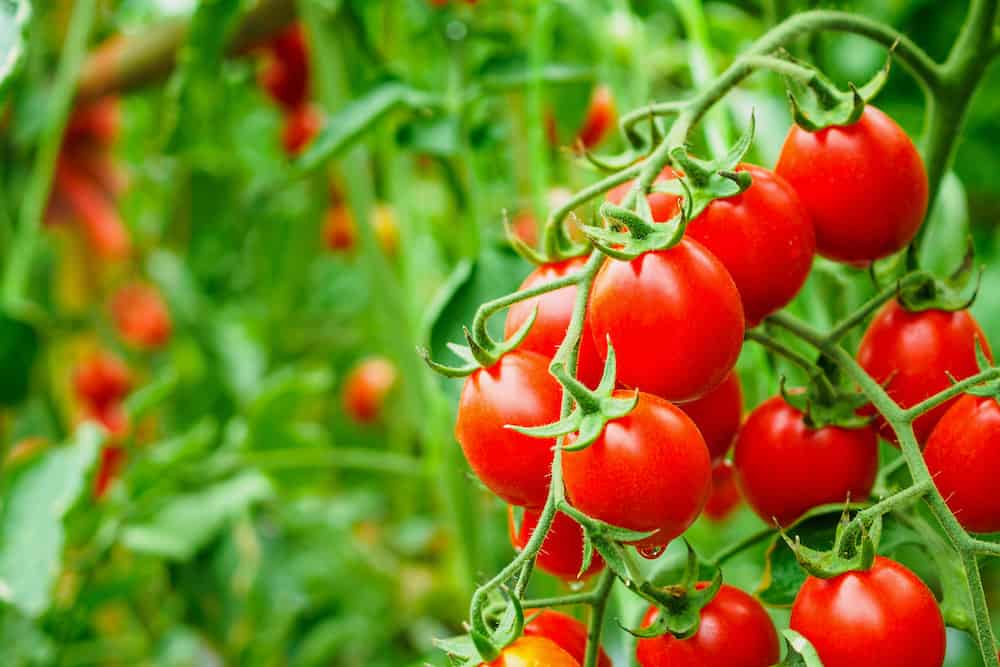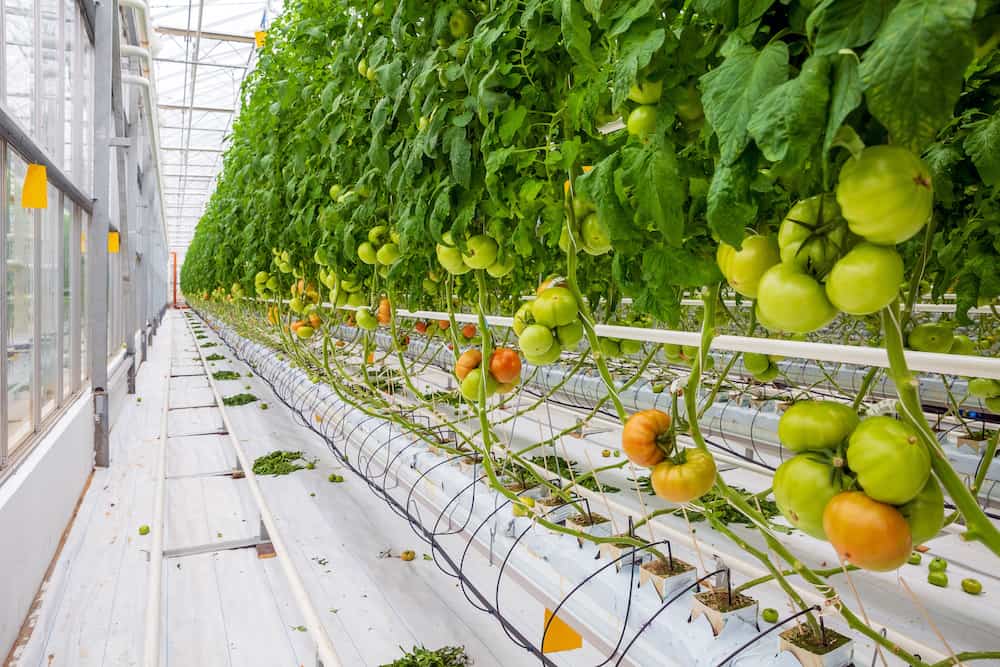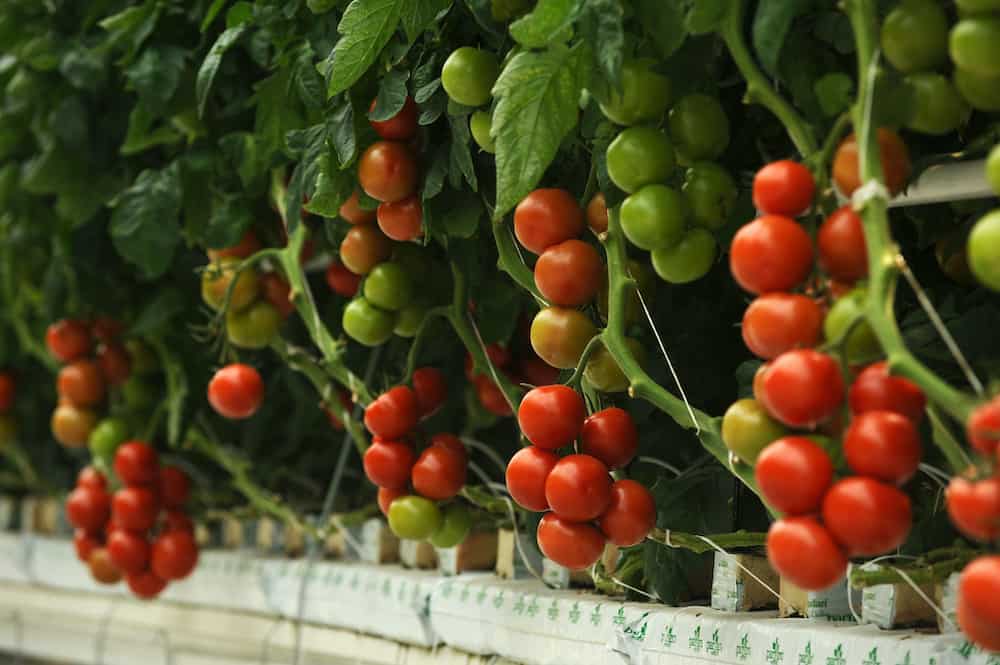Technically a fruit, the tomato is an extremely versatile savory food you can grow and enjoy all year round. No matter what kind of gardening experience you have, you can learn how to grow hydroponic tomatoes.
We discuss the pros and cons of growing hydroponic tomatoes, so you can decide whether it’s right for you. You will also learn all the information you’ll need when growing your own hydroponic tomatoes, including what kind of setup you should use and how to care for them from start to finish.
Hydroponic Tomatoes
Hydroponic gardening is very simple to master. There’s also a lot less manual work involved compared with traditional gardening methods. That’s not to say that there is less work—rather, there is less physically demanding work. Hydroponics is the process of growing plants without soil or any soil-based substrate. It is a type of horticulture that uses a concentrated mineral nutrient solution added to water, which is then applied directly to the roots of the plants.
The plant grows roots either directly in the water or, for heavier plants, in an inert substrate, such as clay pebbles, sand, coco, or gravel.
Substrates help heavier plants anchor themselves down. While researching different hydroponic setups, you may come across systems, including:
- Aeroponics
- Nutrient Film Technique or NFT
- Ebb and Flow
- Hydroponic Drip
- Deep Water Culture

- It’s important to regularly prune indeterminate tomatoes when growing hydroponically.
Pros and Cons of Growing Hydroponic Tomatoes
There is a long list of benefits to be enjoyed when growing tomatoes hydroponically, but there can also be some challenges. We’ve highlighted the main advantages and disadvantages of hydroponic tomatoes here, so you can make an informed decision as to whether it’s right for you.
Pros to growing tomatoes hydroponically:
- Growth Rate
When grown in favorable conditions, tomato plants are able to grow 30% to 50% faster in hydroponics than they do when grown in soil.
- Production Yield
It’s estimated that, under the right conditions, you can expect between three and 10 times the yield compared to traditional methods.
- Cleanliness
Hydroponics is a much cleaner operation due to the lack of soil. Therefore, it is better suited to indoor grows. It’s also ideal for areas close to your home, such as a patio or deck.
- Growing Season
Growing indoors with the correct lights and temperature allows you to grow all year round.
- Water Efficiency
Hydroponics systems have 90% more effective water usage than soil-based gardening methods.
- Location
You can grow hydroponic tomatoes anywhere, regardless of soil quality in the area.
Cons to growing tomatoes hydroponically:
- Start-Up Cost
Unless you’re building the system yourself, setting up a hydroponics system will be more costly than preparing a soil garden for planting.
- Less Room for Error
Mistakes such as wrong pH levels, overfeeding, and over-watering, are magnified in hydroponics. It seems odd to think you could over-water in hydroponics but it’s possible. Plants need oxygen as well as the opportunity to respire.
When growing tomatoes hydroponically, you’re working with the plants’ roots directly, and there is no soil to act as a buffer.
- Need to Prune
Depending on the tomato variety and how much space you have in your hydroponics system, you may need to prune the tomato plants. If the plants get so large that they start reaching the grow lights, you will need to cut them back.
To prune tomato plants successfully:
- Look for vertical stems.
- Use gardening sheers or kitchen scissors to cut the vertical stem a quarter inch to a half inch above where stems are branching off.
Pruning will keep the tomato plants’ size in check and prevent them from getting unruly. In addition, it will help the plant use its energy toward growing tomatoes instead of stems and leaves.
Also, it will be helpful to know whether you are growing determinate tomatoes or indeterminate tomatoes. Determinate tomatoes will grow bushy and are often preferred for hydroponic growing because they are more compact.
Indeterminate tomatoes grow similarly to determinate except they vine out more. If you are growing indeterminate tomatoes hydroponically (or in soil or other gardening method), you should snip new growth that occurs between a main stem and an offshoot. This will refocus the energy toward growing more tomatoes.
What Is the Best Hydroponic System for Tomatoes?
Tomatoes grow really well in all kinds of hydroponic systems, so whichever one you choose is really down to personal preference. We really like the ebb and flow system, as it’s one of the most simple setups that you could easily build yourself.
An ebb and flow system is also known as the flood and drain system. It consists of a reservoir, flood or grow table, a water pump, and a timer. It works by flooding the plant roots with nutrients on a regular basis.
The water pump will flood the tray a couple of times a day with your mineral nutrient solution. The water will then run off back into the reservoir.
How Do You Grow Hydroponic Tomatoes at Home?
The easiest way to get set up is to buy a complete ebb and flow hydroponics system. Whether you want to DIY or buy a kit, you should be able to find these at your local garden center or hardware store.
Here’s a list of things you need to set up a basic ebb and flow system, including extra considerations you’ll have to make when growing indoors.
Ebb and Flow System Setup
The great thing is once you have your hydroponics system in place, you can start growing tomatoes. You can try to build some of these parts yourself.
1. Grow Tray
The grow tray will house the tomato plant pots, so pick a size that is big enough for all the plants you want to grow in this one system. It needs to have high enough sides to keep the water from overflowing. There should also be an overflow drain that leads back to the reservoir.
2. Reservoir
The reservoir is where the nutrient solution is stored, as well as the water pump. It’s very important that the solution isn’t exposed to light, so it needs a lid, which will also help to keep unwanted particles out.
3. Tray Stand
The tray stand will elevate the grow tray off the floor, allowing gravity to drain the nutrient solution back into the reservoir. It also brings your tomato plants up to a much more comfortable working level and allows you to store the reservoir underneath the stand, thereby saving space.
4. Water Pump and Timer
The hydraulic water pump and timer have the most important jobs in the ebb and flow set up, as they’re responsible for making sure your tomato plants get fed.
Make sure the water pump is submersible and that the timer has the capabilities you need for your hydroponics feeding schedule.
5. Fittings
Check if you have all the fittings to connect your timer to your water pump. You’ll also need tubing and fittings to carry the nutrient solution from the pump to the reservoir, and then back again down through the drain.
Make sure the tubing and fittings are of good quality to avoid leaks.
6. Plant Pots
Most hydroponic growers use either net pots or fabric pots. Unlike traditional plant pots, they allow plenty of space for the roots to grow through and receive plenty of oxygen. You want to ensure the tomato plants’ roots don’t rot.
7. Growing Substrate
Tomato plants can grow to be very large and heavy, so you’ll need to use a growing substrate. The most popular growing media for tomatoes is expanded clay pebbles, which are completely inert and pH neutral.
Because they don’t retain water, you’ll need to make sure the plants are regularly watered. They are also very heavy, so make sure your stand is strong enough to hold the weight. They are reusable, though, so just wash and sterilize them before using them again.
Growing Hydroponic Tomatoes Indoors
If you’re setting up your hydroponics system indoors, you’ll also need some grow lights to ensure that your tomatoes receive adequate light. You’ll also need adequate ventilation, and if you want to be able to grow tomatoes all year round, a way to control the temperature.
1. Lights
Your tomato plants should have 8 – 10 hours of direct sunlight or bright light per day. Many high yield tomato plant varieties thrive with 12 to 18 hours of light each day. For this, you’ll need to purchase special grow lights, which vary in size and price.
LED grow lights are by far the most efficient and powerful, but they are also the most expensive. Fluorescent lights are more affordable and will give you great efficiency on less power. If you’re on a budget, however, high-pressure sodium vapor (HPS) lights may be your best option.
2. Temperature
Tomatoes love warmer weather, so if you want to grow year-round, then you’ll need a way to heat the room up in the winter.
If you’re growing in a basement, which stays on the cooler side even during summer, then you’ll need to think about how to increase the year-round temperature. Consider also dampness and humidity.
3. Ventilation
Like the bathroom and kitchen, or any other room in the house that has water in it, you should also make sure that the area has good airflow. Decent ventilation will prevent you from getting mold in your hydroponics system, as well as on the leaves, branches, and tomatoes.

- Growing tomatoes hydroponically is popular.
Tomato Plants, Nutrients, and Plant Care
Once you’ve got your ebb and flow hydroponic system set up, it’s time to start thinking about what kind of tomatoes you’re going to grow. You’ll also have to make a decision as to which nutrient package you’re going to feed your tomatoes with.
Tomato Cultivars
Tomato cultivars can be split into two broad categories of determinate and indeterminate tomatoes.
- Determinate varieties grow like a bush. If you’re limited on space, then this should be your preferred choice. Determinate tomato plants will bear fruit all within a matter of weeks.
- Indeterminate varieties grow on vines, so you’ll also need to set up some A-frames or trellis to help support them as they grow. Indeterminate tomatoes will bear fruit throughout the growing season as long as their needs are met.
Depending on the type of tomatoes you choose to grow, make sure you give them enough space. It’s also nice to have a bit of wiggle room so that you can move the plants around to make for easier pruning.
Seeds or Seedlings?
Transplanting seedlings that grew in soil isn’t ideal, as they could be infected with pests or germs. Just one infected seedling from growing tomatoes in pots or a garden bed could take down an entire tomato crop, so many hydroponic growers prefer to grow their own seedlings indoors.
Rockwool cubes make an ideal growing substrate for germinating seeds. To do this, you just need to add the seeds and wet down the wool.
The tomato seeds need a warm, moist environment in order to sprout, so cover them up and place them on your windowsill until they sprout. Tomato seeds should sprout within 10 days and can be transferred to your hydroponic system as soon as they are around eight inches tall.
Nutrients
Make sure you buy a nutrient package that is specifically designed for growing in a hydroponic system. Other nutrient packages may cause the system to clog up, which could have devastating results on your grow operation.
Hydroponic tomatoes have pretty high nutritional needs. Look out for a package that is high in nitrogen (N), phosphorus (P), and potassium (K), which is commonly referred to as NPK.
Tomatoes also need other nutrients, such as magnesium, so see if your local garden center sells a package specifically designed for tomatoes.
Plant Care
Your main task when caring for the tomato plants once they’re growing is to check up on them to make sure they’re healthy and that everything’s working properly.
1. Change Solution
You’ll need to change out the solution in your reservoir approximately once a week, depending on your feeding schedule.
2. Check pH Level
Checking the pH level of your solution on a regular basis is also important. This ensures that your tomato plants are able to use all of the nutrients effectively. The preferred pH level of tomato plants is between 5.5 and 6.5. However, they thrive best when the pH is between 6 and 6.5, so you’ll need to adjust it from time to time.
Vinegar and citric acid will lower the pH level, while baking soda will increase it, but they’re more short-term fixes. Most people tend to use special pH lower and pH higher solutions, which offer longer-term fixes.
3. Prune Tomato Plants
Once the tomato plants start getting big, you’ll most likely need to start training and pruning them so that they don’t get out of control. Pruning is especially important for indeterminate varieties which are vining type tomato plants. These will produce tomatoes for many seasons. You want to keep the tomato plants’ energy on growing tomatoes, not more branches and leaves.
4. Check for Tomato Hornworms
Though you won’t likely have tomato hornworms when growing tomatoes hydroponically indoors, if your setup is outside, there is a chance. Watch for bite marks or missing leaves.
How Long Does It Take to Grow Hydroponic Tomatoes?
How long it takes to grow tomatoes hydroponically depends on the cultivar you picked and whether you started from seed or seedling. On average, it will take 10 days for tomato seeds to germinate and between four and six weeks to reach the transplanting stage. Then, you’ll need to wait anywhere between four and eight weeks before they start fruiting.
You can begin harvesting the fruit as soon as it starts to go red, and it will continue ripening in the fruit bowl.
If you’re growing indoors and can provide your plants with light conditions and temperature they need to produce, then once you start harvesting, you’ll never stop!
Growing tomatoes is one of the best plants for hydroponics systems.
How Much Light Do Hydroponic Tomatoes Need?
It’s important tomatoes growing hydroponically get enough light in order to thrive. Many varieties need 8 – 10 hours of sunlight each day. Other varieties, including high yield tomato plants, need up to 18 hours of light per day.
How to Grow Hydroponic Tomatoes
Now you know how to grow hydroponic tomatoes, you could be enjoying your own homegrown fruits in as little as eight weeks.
Once you’ve decided where you’re going to put your hydroponic system, measure the space, and buy the equipment you need. Then, after you have everything set up and ready to go, the water pump and timer will do a lot of the work for you.
Check on your hydroponically-growing tomato plants weekly. Regular pruning and care will ensure you get the most bountiful and beautiful crop.
Roma Tomatoes ~ What They Are and How to Grow Them
Beefsteak Tomatoes ~ How to Use and Grow these Mighty Tomatoes
Hydroponic Greenhouse Systems Kits


Wow! Very helpful! Thank you
My tomato plants are getting tall. taller than the grow lite, how do I manage this. I have raised the lite. The plants do have small tomatoes. Growing tiny Tim dwarf
It’s great that you are growing tomatoes hydroponically. As you are experiencing, with good conditions — nutrition and light — tomato plants grow large in hydroponics. No matter whether you have indeterminate tomato plants (tall and vining) or determinate tomatoes (large and bushy) they can grow too large for the space.
You can prune the tomato plants so they will fit better. Pruning also has the benefit of directing the plant’s energy toward growing tomatoes instead of additional foliage. To prune safely and to keep the plant productive, look for vertical stems. Use strong scissors or gardening shears and cut the vertical stems 1/4 inch – 1/2 inch above wherever there is a side stem branching out underneath it.
I know said you are growing Tiny Tim dwarf tomatoes which are determinate. However, for anyone else reading who is growing indeterminate tomato plants hydroponically or in soil, you should also snip off new growth that grows between a main stem and a side stem. This isn’t to curb the plant’s size so much as it is to direct more energy toward producing fruits.
I hope you grow lots of delicious tomatoes!